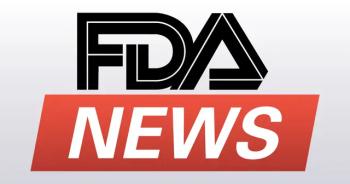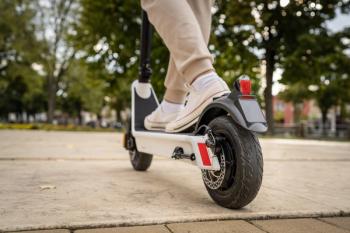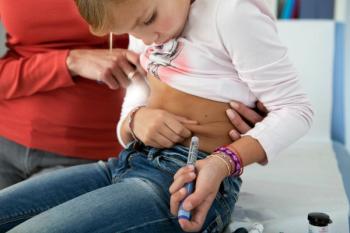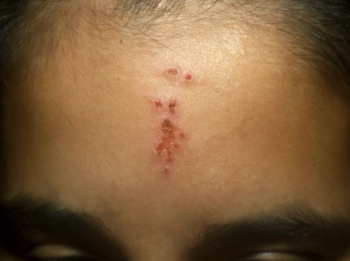
New products for pediatrics: 2002
New this year: An online service to help you practice evidence-based medicine, a panoramic ophthalmoscope, an all-in-one vital signs monitor, an office glycosylated hemoglobin assay, a circumcision chair, and electronic products to help you keep in touch. And more.
New products for pediatrics: 2002
By Andrew J. Schuman, MD
New this year: An online service to help you practice evidence-based medicine, a panoramic ophthalmoscope, an all-in-one vital signs monitor, updated temporal artery thermometers, compact hemoglobin analyzers, an office glycosylated hemoglobin assay, a circumcision chair, electronic products to help you keep in touchand more.
Many will remember 2002 as the year that the United States mounted a war on terrorism, the stock market went on a roller coaster ride, and corporate America learned the importance of being honest as well as earnest. In a turbulent time, pediatricians had to restrict immunizations because routine vaccines were in short supply and were advised that their practices would need to comply with the privacy rule of the Health Insurance Privacy and Accountability Act (HIPAA) by April 2003.
As in years past, a number of noteworthy medical devices, technologies, and products were introduced that may improve the way we practice pediatrics. In addition to the usual smorgasbord of new products, I present a brief update on communication technologies that may improve our ability to keep in touch with patients, hospitals, and pharmacies.
Evidence-based medicinemade easy (really)
For several years, we pediatricians have been advised to consider practicing evidence-based medicine (EBM), using online tools to ensure that we implement treatment and diagnostic regimens that have been validated by medical research.13 As a practical matter, those of us in the trenches of pediatric medicine have found EBM to be a challengeto say the least. But a new online service should help us get where we've been exhorted to go.
I've long been a fan of MD Consult, an Internet-based, online subscription service ($220 a year) that gives physicians access to more than 40 textbooks, full text of 50 journals, 600 practice guidelines, nearly 3,000 patient handouts, and prescribing information on more than 30,000 medications. Apparently, I am not the only avid user. MD Consult reports that, since the service was introduced in 1997, it has attracted more than 250,000 subscribers and is routinely used by more than 1,000 hospitals and medical facilities, including more than 90% of US medical schools.
The benefit of the service, of course, is ready access over the Internet to pediatric textbooks and other useful medical texts, including the Report of the Committee on Infectious Diseases, the Harriet Lane Handbook, and Nelson's Textbook of Pediatrics. The full text of popular journals, including Pediatrics, the Journal of Pediatrics, and Pediatric Clinics of North America, is available as well.
Elsevier Science, the publishing company responsible for MD Consult, has launched a complementary service, PDxMD, that they describe as "a new, evidence-based, primary care clinical information system." The service integrates three useful features: a differential diagnosis tool, a medical condition knowledge base, and patient information materials. These features simplify the process of reviewing existing medical evidence relating to the diagnosis and treatment of more than 350 medical complaints.
When you select the differential diagnosis tool, presenting signs and symptoms are listed alphabetically. Selecting a symptom activates a quick-access chart listing potential diagnoses, organized by age. Clicking on the appropriate diagnosis brings up a "diagnostic pathway" matrix that helps distinguish one condition from another.
The medical condition knowledge base, with more than 450 entries, is also organized alphabetically. Each condition is described in detail, along with associated criteria necessary for diagnosis and a comprehensive presentation of differential diagnoses and treatment options. The knowledge base also includes comprehensive listings of research and analyses relating to the medical evidence supporting the information presented. According to Elsevier Science, PDxMD develops and updates the knowledge base using a collaborative authoring process that integrates information drawn from the Cochrane Database, the National Guidelines Clearing House, MD Consult, Clinical Evidence (British Medical Journal Publishing Group), consensus statements, and peer reviewed articles. Last, the patient information files (more than 300 entries) permit physicians to present patients with relevant information regarding their condition.
For a reasonable annual subscription fee of $299, PDxMD provides one-click access to evidence-based medical information via the features described above. A bonus is a free downloadable version of the software that you can install on your PDA (you do have a PDA, of course) for occasions when the Internet is not readily available.
A panoramic ophthalmoscope
This year pediatricians can perform a more thorough eye examination by using the new Welch Allyn PanOptic Ophthalmoscope (Figure 1), which features what Welch Allyn calls Axial PointSource Optics. A series of lenses and mirrors converge halogen illumination to a point at the cornea and then enable the illumination pathway to diverge to the retina. The result is a very wide illuminated area of the fundus.
This $599 devices fits on any 3.5 v handle and looks like a small telescope. A reusable eyecup attached to the patient end of the device fits over the orbit of the patient's eye, shielding the eye from light and stabilizing the ophthalmoscope on the patient's forehead. It also functions as a pivoting point for panning around the retina. The physician controls include a vertically oriented focusing wheel; an aperture dial that allows selection of micro, small, and large spot sizes; a red-free filter; a cobalt blue filter for corneal exams; and a slit aperture.
Learning how to use the PanOptic Ophthalmoscope effectively requires a little patience and practice (reading the manual is a must!). Mastering the technique rewards the physician with a field of view that is five times larger than that of standard scopes as well as a 26% increase in magnification. Obviously, the patient's cooperation is necessary to use the device, but the examination itself takes about the same time as a standard funduscopic exam. In addition to routine examination, the scope could be extremely helpful in screening for a retinal bleed after head trauma or evidence of papilledema in a child with headache.
Expediting vital signs
Obtaining vital signs in a busy pediatric practice is time-consuming because the nurses must use separate instruments to take temperature, pulse oximetry measurements, and blood pressure. The Spot Vital Signs, another new product from Welch Allyn, integrates all these instruments into a single device that takes noninvasive blood pressure, pulse rate, temperature, and pulse oximetry measurements quickly and easily (Figure 2).
The automatic blood pressure cuff is first applied to the patient's arm, and the "Measure" button is depressed, activating the measuring cycle of the cuff. The device measures pulse rate automatically along with blood pressure. The temperature sensor is then placed in the patient's mouth and the pulse oximetry sensors on the finger; the results appear in about 30 seconds on a large LCD display screen.
The unit weighs just 4 lb and has an internal rechargeable battery. It can be mounted on the wall, carried in the hand, or held on a portable stand offered by the manufacturer ($200). If you mount the unit next to a scale, you can take vital signs while measuring height and weightaccelerating the process of readying the patient for examination.
The base unit, which includes the blood pressure and pulse modules, costs $805. Adding temperature capability increases the price tag of the unit to $1,125; adding pulse oximetry raises the price to $1,980. Keep in mind that, because pulse oximetry is considered a diagnostic procedure that is reimbursed by most insurance companies, the unit generates revenue for your practice; depending on the number of patients you see, the Spot Vital Signs can pay for itself in a matter of months.
Temporal artery thermometry, for everyone
In 1999, Exergen Corporation, an innovative company responsible for the development of many infrared thermometry technologies, introduced a new line of temporal artery scanning thermometers.4 The company reports that it has since discovered, in its research, that the medical community prefers temporal artery scanners to ear canal thermometers because they are accurate and easy to use. The latest models of Exergen's office temporal artery thermometers also are more affordable than ever. The TAT-4000 TemporalScanner sells for about $270 and uses an inexpensive probe cover ($75 per 1,000); the LXTA/TAT-5000 TemporalScanner (Figure 3) can be used with or without probe covers and sells for about $350. Both come with a lifetime warranty.
This year, Exergen has begun marketing a temporal artery thermometer for home use. The TAT- 2000C TemporalScanner is a sturdy thermometer that doesn't require a probe cover (Figure 3). The parent simply depresses the button on the instrument and lightly scans across the child's forehead, then releases the button to display the temperature. If there is perspiration on the forehead, which can decrease the recorded temperature through evaporation, the user also presses the scanner against the child's neck behind the ear before releasing the button. According to the manufacturer, most parents report that the device is much easier to use than an ear thermometer, and children find it easier to cooperate with TA measurements. The TAT-2000C can be purchased for about $60 at drugstores and Target stores and online at babiesrus. com. It comes with a training video on a CD-ROM.
Two small analyzers
For well over a decade, most hemoglobin testing in physicians' offices has been performed with the HemoCue Hemoglobin Analyzer. Pediatricians have long appreciated this device's ease of use, accuracy, and one-button operation. This year, GDS Medical is launching a hemoglobin analyzer, the STAT-Site M Hgb (Figure 4), to compete with the HemoCue analyzer.
The STAT-Site M Hgb is a battery-operated, palm-sized device that performs a hemoglobin assay on a single drop of whole blood in seconds. A drop of blood from a fingerstick is placed in the testing well on a $1 test card fitted into the device, which displays the hemoglobin result a few seconds later. The analyzer also has a recall button that displays the previous measurement when pressed.
Each Stat-Site M Hgb unit costs about $160, so one could consider equipping each examining room with an analyzer and testing supplies to facilitate testing. Like the HemoCue, the analyzer is considered a waived test under the Clinical Laboratory Improvement Amendments of 1988 (CLIA '88).
HemoCue has just released a pocket-sized glucose analyzer. The HemoCue Glucose 201 Analyzer (Figure 5) weighs less than a pound and, like the HemoCue Hemoglobin Analyzer, uses $1 disposable cuvettes to perform assays. The cuvette is filled by dipping the tip in a drop of fingerstick blood and placed in the analyzer. The result appears seconds later. The Glucose 201 Analyzer is not a glucose meter but rather an analytic lab device that can be used to diagnose and screen for diabetes as well as to monitor diabetic patients and perform glucose tolerance tests.
The device, which is classified as a waived test under CLIA '88 guidelines, retails for about $499. A box of 100 cuvettes costs approximately $98.
Glycosylated hemoglobin assays in the office
Pediatricians who perform office cholesterol testing are likely to be familiar with the LDX from Cholestech Inc. The unit, classified as a waived device under CLIA '88, performs a complete lipid profile, including total cholesterol, high-density lipoprotein, low-density lipoprotein, very-low-density-lipoprotein, and triglycerides. It can also measure serum glutamate pyruvate transaminase and glucose. Cholestech has just begun marketing a new analyzer, Cholestech GDX (Figure 6), that measures hemoglobin A1c. As you are aware, hemoglobin A1c is used to monitor how well type 1 or type 2 diabetes is controlled. The level of A1c, which projects a two- to three-month average of the blood glucose level, is typically used as a baseline before instituting therapy and to monitor the efficacy of treatment.
Fingerstick blood is drawn into a sample tube and added to a test solution. The solution is added to the test cartridge and results are displayed in five minutes. The GDX costs $895; a box of 12 test cartridges costs $95.
A better adhesive bandage
It's often simplicity of design that distinguishes a superior medical product. Most pediatricians and nurses, who are expert at administering vaccines, can be frustrated by the application of an adhesive bandage to cover the injection site. I've recently discovered QwikStrips, adhesive bandages that are designed to be easy to apply even with a gloved hand (Figure 7). Application is simple a tab on the wrapper is pulled, carrying the strip with it. The tab is then placed over the injection site and removed, leaving the bandage in place.
QwikStrips come in traditional boxes or a large matchbook that helps organize the strips for ready access. They cost about $.03 each, depending on the quantity purchased.
A friendlier circumcision chair
According to pediatrician Howard Stang, MD, there is a more humane way to position newborn infants for circumcision. Dr. Stang, who estimates that about a third of all hospital newborn circumcisions are performed by pediatricians, has redesigned the traditional circumcision restraint board to create a "circ chair" that positions the infant more comfortably in a frog-leg position while providing access to the operative site (Figure 8). The circ chair has comfortable foam pads and padded Velcro restraints that prevent movement during the procedure.
Five years ago, Dr. Stang published a study that evaluated measures that could be used with dorsal penile nerve block to reduce the newborn's stress during routine circumcision.5 He discovered that liberal use of a pacifier soaked in 24% sucrose along with the padded, physiologic circ chair made the procedure more tolerable for infants. The circ chair is available from Pedicraft for about $350.
Fun products for patients and pediatricians
Part of the challenge of practicing pediatrics is to make the threatening experience of an office visit as pleasant as possible for our young patients. To accomplish this, we wear amusing ties or small animals on our stethoscopes, design our waiting areas and examining rooms to be kid-friendly, and do everything possible to distract children during painful procedures such as suturing or vaccination.
PediaPals is a company that specializes in products to help achieve a kid-friendly office atmosphere. For starters, PediaPals manufactures ZooPals, fiberglass examination tables that are shaped like large smiling animals (Figure 9). They have all the features of any fully equipped examination table, including a built-in paper roll holder and an elevated back, and come in a variety of colors. Full-size tables (dinosaur, elephant, lion, and polar bear) sell for $3,495. Compact tables without drawers (puppy, dolphin, and turtle), sell for $2,395. All tables can be purchased with a coordinated decal kit to decorate the walls of the examination room ($245).
PediaPals also has its own versions of many of the tools that we use everydaya giraffe-shaped reflex hammer ($12), a disposable elephant otoscope speculum ($13 for 100), and cloth animal covers ($17) to disguise a stethoscope to look like a dinosaur, Dalmatian, lion, or tiger. A new product, an animal-shaped protector for intravenous catheters ($2.50 each), features a magnification window for viewing the site and 3M medical tape fasteners to secure the unit and provide a writable surface.
You can purchase an assortment of the PediaPal office products for $160. It includes the products mentioned directly above as well as a "Benjamin Bear" blood pressure kit, frog penlights, and several other intriguing items. These patient pleasers just might transform your practice into a kid-friendly zoo.
The mobilePDR
Any truly electronic pediatrician is the proud owner of a personal digital assistant (PDA) that he or she uses to keep track of important phone numbers and appointments. The PDA can also be used as a portable medical library because many standard pediatrics references, such as the Report of the Committee of Infectious Diseases and the Harriet Lane Handbook, have become available for installation on PDAs (see "New products for pediatrics: 2000," in the December 2000 issue, also accessible at
This year Thomson Healthcare, the parent company of Medical Economics, Contemporary Pediatrics, and the Physicians' Desk Reference (PDR), has produced a version of the PDR, the mobilePDR, that can be installed on your PDA at no cost to you. Versions are available for PDAs that use either the Palm or Windows CE operating system and are easy to download and install. Installation does require an active Internet connection because the PDR queries the PDR Internet Server to download and install the latest update into the PDA.
Medications are organized by brand or generic name, indication, or therapeutic class, and each medication entry includes the drug's therapeutic category, available dosage forms, indications, dose, contraindications, precautions, drug interactions, and adverse reactions. All entries are cross referenced to a page in the print PDR. A "What's new" section includes the latest information about new drugs and vaccines and new indications for existing medications.
Staying in touch
Much of the practice of pediatrics involves communicating with patients, hospitals, and pharmacies by means of cell phones and pagers. Although pagers have evolved only slightly in recent years, cell phone services have improved dramatically, and the devices themselves have become quite sophisticated. When I recently upgraded my Nokia phone, purchased only two years ago, to a current version, I discovered a wealth of new, useful features, including some very helpful PDAlike functions. I can keep track of upcoming appointments and phone numbers and transfer all entries to my computer's personal information manager or my PDA by means of an infrared uplink. Integrated voice recognition technology speeds the dialing of frequently called numbers, and I can record voice-reminder memos for playback at my convenience. Some phones also provide Internet access.
In the near future, most cell phone users will be able to upgrade their current phones to so-called smart phones, which are essentially PDAs with cell phone capability. T-Mobile (formerly Voicestream) is one of the first companies to introduce this service in the US with the Pocket PC Phone Edition. The $500 unit, which looks like a PDA with a small antenna, provides Internet access, e-mail connectivity, and full PDA function (including calendar, contact lists, and word processing) and is a fully functional cell phone as well. Numbers can be dialed directly from the contact list, and caller ID identifies each incoming call. The PDA synchronizes all information with a desktop computer via an uplink caddy. You can also install your mobilePDR software and PDA pediatrics reference books into the unit.
Even automobiles are integrating communication technology. My new GMC vehicle has a built-in, voice-activated cell phone that leaves my hands free during use for safe driving. The system and service is provided by OnStar (a subsidiary of GMC) and requires activation at the dealership. Pressing a button on the rear-view mirror activates a pleasant, maternal sounding voice that says "ready," indicating the system is waiting for input to make a call. The system can call numbers that I program into it, which become associated with voice tags, such as "office," "nursery," or "home." Alternatively, it will dial any telephone number I input verbally by slowly reciting the number. OnStar is currently available on GMC cars and various models of Honda, Acura, Audi, and Saab, and is well worth considering if these makes of cars interest you. The basic package costs $16.95 per month: Additional options, listed at the Onstar Web site (
Are you curious?
I hope this year's offerings have stimulated your curiosity. More information can be obtained by calling the vendors of the products directly or visiting their Web pages (see the
REFERENCES
1. Bauchner H: Evidence-based medicine: A new science or an epidemiologic fad? Pediatrics 1999;103:1029
2. Sackett DL, Rosenberg WMC, Gray JAM, et al: Evidence-based medicine: What it is and what it isn't. BMJ 1996;312:71
3. Evidence-Based Medicine Working Group: Evidence-based medicine. JAMA 1992;268:2420
4. Schuman AJ: New products for pediatrics: 1999. Contemporary Pediatrics 1999;16(12):38
5. Strang HJ, Snellman LW, Condon LM, et al: Beyond dorsal penile nerve block: A more humane circumcision. Pediatrics 1997;100(2):E3
6. Schuman AJ: New Products for pediatrics: 2000. Contemporary Pediatrics 2000;17(12):41
DR. SCHUMAN is adjunct assistant professor of pediatrics at Dartmouth Medical School, Lebanon, N.H., and practices pediatrics at Hampshire Pediatrics, Manchester, N.H. He is a contributing editor for Contemporary Pediatrics.
Virginia A. Mason assisted the author in the preparation of the manuscript of this article.
PDxMD/MD Consult
Elsevier Science
MD Consult
11830 Westline Industrial Drive
St. Louis, MO 63146
Tel. 800-401-9962
PanOptic OphthalmoscopeSpot Vital Signs monitor
Welch Allyn Inc.
4341 State Street Road
P.O. Box 220
Skaneateles Falls, NY 13153-0220
Tel. 800-535-6663
TemporalScanners TAT-4000, LXTA/TAT-5000, TAT-2000C
Exergen Corporation
51 Water Street
Watertown, MA 02472
Tel. 800-422-3006
HemoCue Glucose 201 Analyzer
HemoCue Inc
23263 Madero, Suite A
Mission Viejo, CA 92691
Tel. 800-323-1674
STAT-Site M Hgb
Stanbio Laboratory
1261 North Main Street
Boerne, TX 78006
Tel. 800-531-5535
Cholestech LDX cholesterol analyzerCholestech GDX hemoglobin A1c analyzer
Cholestech Inc.
3347 Investment Blvd.
Hayward, CA 94545-3808
Tel. 800-733-0404
QwikStrip adhesive bandages
QwikStrip Products
2355 Bingle Road
Houston, TX 77055
Tel. 888-548-5705
Stang Circ Chair
Pedicraft
P.O. Box 5969
Jacksonville, FL 32247-5969
Tel. 800-223-7649
ZooPals examination tables
PediaPals
965 Hwy 169 North
Minneapolis, MN 55441
Tel. 888-733-4272
mobilePDR
Thomson Healthcare
5 Paragon Drive
Montvale, NJ 07645
Tel. 888-632-9998
Smart phone cellular service
T-Mobile USA
12920 SE 38th Street
Bellevue, WA 98006
Tel. 800-937-8997
Automobile cell phone service
OnStar
Tel. 800-onstar7
Andrew Schuman. New products for pediatrics: 2002.
Contemporary Pediatrics
2002;12:69.
Newsletter
Access practical, evidence-based guidance to support better care for our youngest patients. Join our email list for the latest clinical updates.














